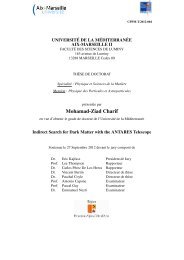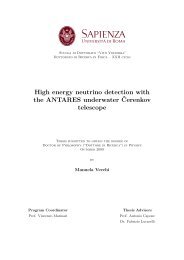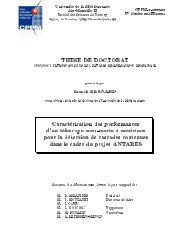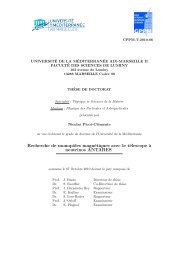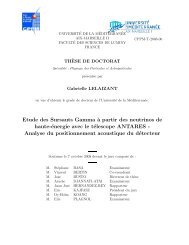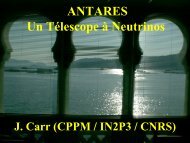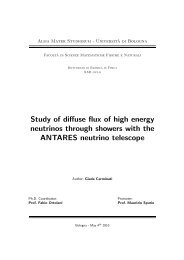Autocorrelation analysis of ANTARES data 1 Introduction
Autocorrelation analysis of ANTARES data 1 Introduction
Autocorrelation analysis of ANTARES data 1 Introduction
You also want an ePaper? Increase the reach of your titles
YUMPU automatically turns print PDFs into web optimized ePapers that Google loves.
s<br />
F. SCHÜSSLER et al. <strong>ANTARES</strong> AUTOCORRELATION<br />
significance < D W [s ]<br />
2.5<br />
2<br />
1.5<br />
1<br />
0.5<br />
0<br />
2<br />
1.5<br />
1<br />
0.5<br />
0<br />
-0.5<br />
-1<br />
-1.5<br />
-2<br />
0 0.5 1 1.5 2 D W<br />
[deg]<br />
-0.5<br />
-1<br />
-1.5<br />
-2<br />
-2.5<br />
0 20 40 60 80 100 120 140 160 180<br />
angular distance D W [deg]<br />
Figure 4: The significance <strong>of</strong> intrinsic clustering <strong>of</strong> <strong>data</strong> taken with the <strong>ANTARES</strong> neutrino telescope in 2007/2008. The<br />
trial factor is not corrected for. The inset shows an enlarged view <strong>of</strong> the significance for small angular distances.<br />
172<br />
173<br />
174<br />
175<br />
176<br />
177<br />
178<br />
179<br />
180<br />
181<br />
182<br />
183<br />
184<br />
185<br />
186<br />
187<br />
188<br />
189<br />
190<br />
191<br />
192<br />
193<br />
2.5 Results and discussion<br />
The described <strong>analysis</strong> has been applied to the 2090 selected<br />
<strong>data</strong> events recorded by the <strong>ANTARES</strong> neutrino<br />
telescope between 2007 and 2008. The uncorrected significance<br />
as a function <strong>of</strong> the cumulative angular scale is<br />
shown in figure 4. A maximum deviation between the <strong>data</strong><br />
and the reference distribution <strong>of</strong> 1.1 σ is found for an angular<br />
scale < 7 ◦ . Correcting for the scanning trial factor<br />
this corresponds to a p-value <strong>of</strong> 55 % and is therefore not<br />
significant.<br />
In the search for the sources <strong>of</strong> high energy cosmic rays, the<br />
detection <strong>of</strong> astrophysical sources <strong>of</strong> neutrinos may play a<br />
crucial role. Various experiments are currently taking <strong>data</strong><br />
or are in a preparatory phase to achieve this goal and the<br />
recorded <strong>data</strong> is scrutinized in numerous ways in order to<br />
extract a maximum <strong>of</strong> information. We presented here the<br />
first search for intrinsic clustering <strong>of</strong> <strong>data</strong> recorded with the<br />
<strong>ANTARES</strong> neutrino telescope. The <strong>data</strong>, taken during the<br />
deployment phase <strong>of</strong> the detector, do not show evidence for<br />
deviations from the isotropic arrival direction distribution<br />
expected for the background <strong>of</strong> atmospheric neutrinos and<br />
contamination by mis-reconstructed atmospheric muons.<br />
trum unfolding with the <strong>ANTARES</strong> detector, these pro- 200<br />
ceedings, 2011 201<br />
[3] R. Abbasi et al. (AMANDA Collaboration), Search for 202<br />
point sources <strong>of</strong> high energy neutrinos with final <strong>data</strong> 203<br />
from AMANDA-II, PRD 79, 062001, 2009 204<br />
[4] R. Abbasi et al. (IceCube Collaboration), Time- 205<br />
integrated Searches for Point-like Sources <strong>of</strong> Neutrinos 206<br />
with the 40-string IceCube Detector, APJ 732, 18-34, 207<br />
2011 208<br />
[5] M. Ageron et al. (<strong>ANTARES</strong> Collaboration), Point- 209<br />
like source search with 2007-2008 <strong>data</strong>, in preparation, 210<br />
2011 211<br />
[6] C. Bogazzi for the <strong>ANTARES</strong> Collaboration, Search- 212<br />
ing for point sources <strong>of</strong> high energy cosmic neutrinos 213<br />
with the <strong>ANTARES</strong> telescope, these proceedings, 2011 214<br />
[7] F. Aharonian et al. (HESS Collaboration), Primary par- 215<br />
ticle acceleration above 100 TeV in the shell-type super- 216<br />
nova remnant RX J1713.7-3946 with deep HESS obser- 217<br />
vations, A&A 464, 235-243, 2007 218<br />
[8] T.-P. Li and Y.-Q. Ma, Analysis methods for results in 219<br />
gamma-ray astronomy, APJ 272, 317-324, 1983 220<br />
[9] C. Finley and S. Westerh<strong>of</strong>f, On the evidence for clus- 221<br />
tering in the arrival directions <strong>of</strong> AGASA’s ultrahigh en- 222<br />
ergy cosmic rays, APP 21, 359-367, 2004 223<br />
194<br />
195<br />
196<br />
197<br />
198<br />
199<br />
References<br />
[1] M. Ageron et al. (<strong>ANTARES</strong> Collaboration),<br />
<strong>ANTARES</strong>: the first undersea neutrino telescope, to<br />
appear in NIM A, 2011<br />
[2] D. Palioselitis for the <strong>ANTARES</strong> Collaboration, Muon<br />
energy reconstruction and atmospheric neutrino spec-




